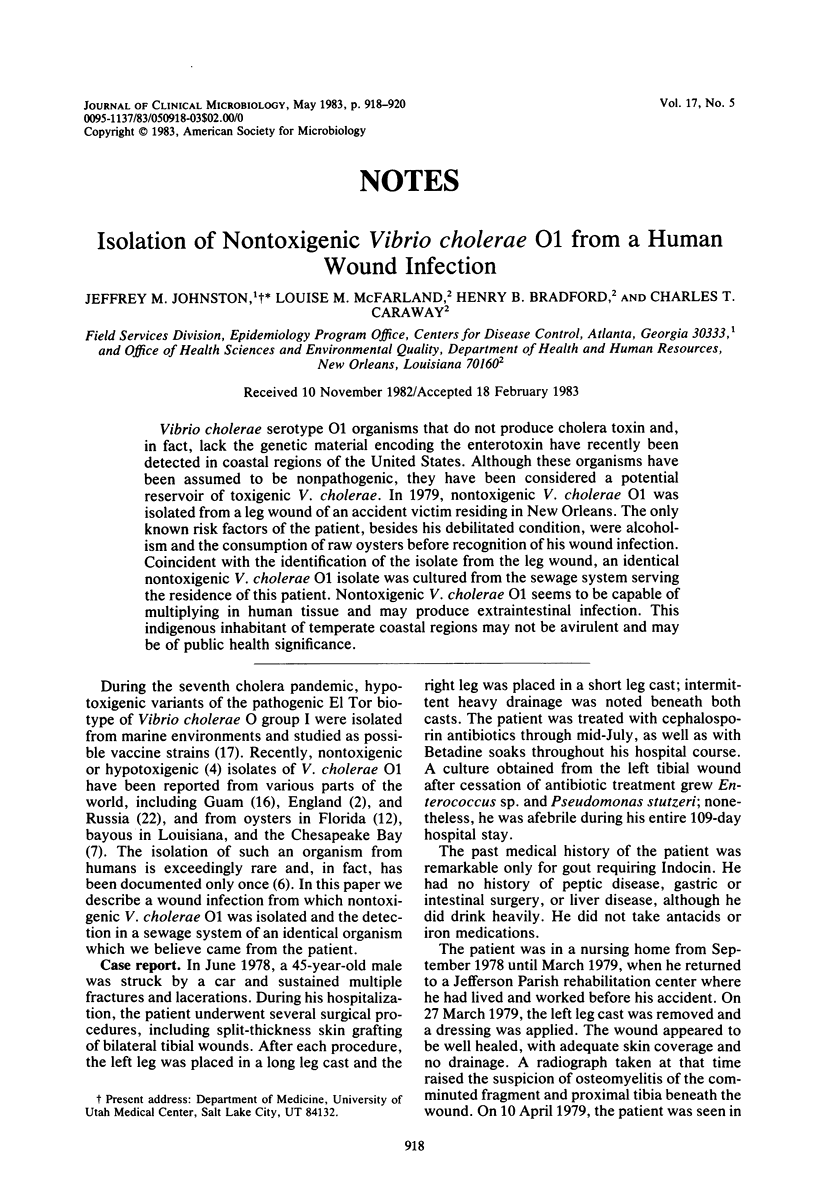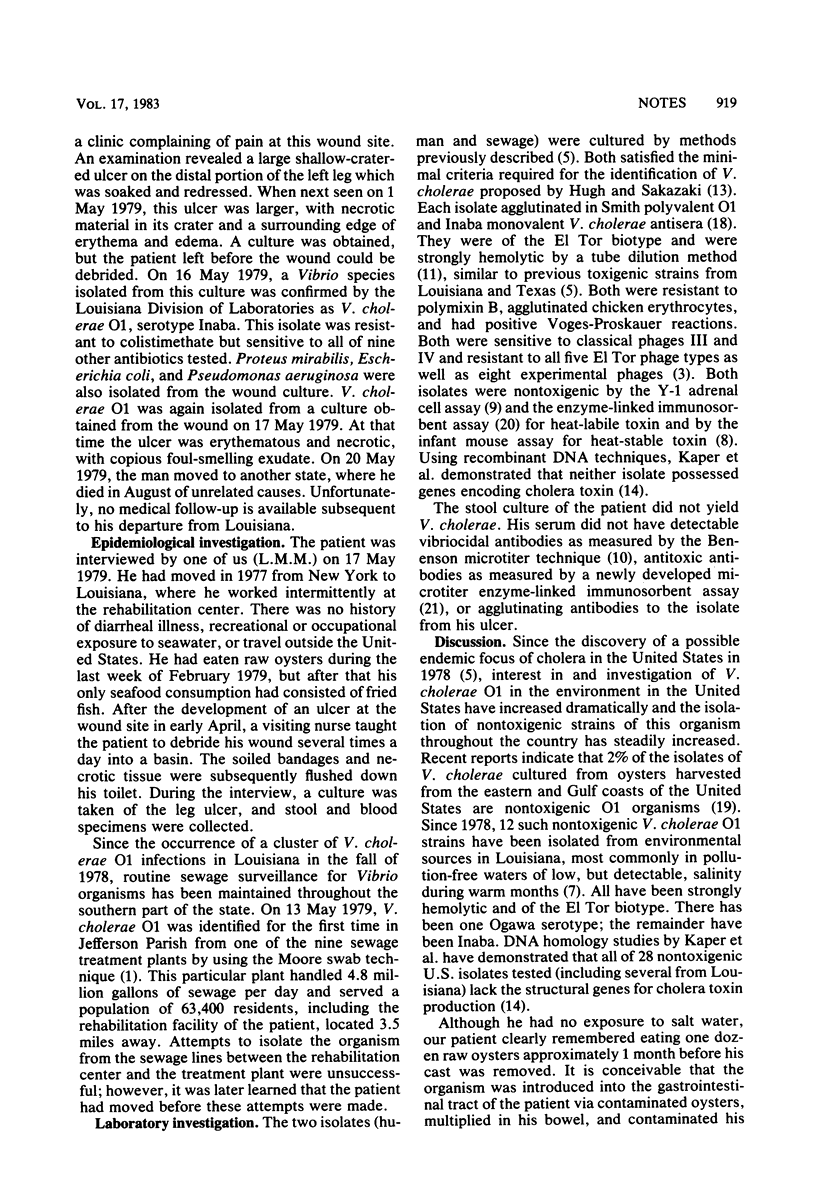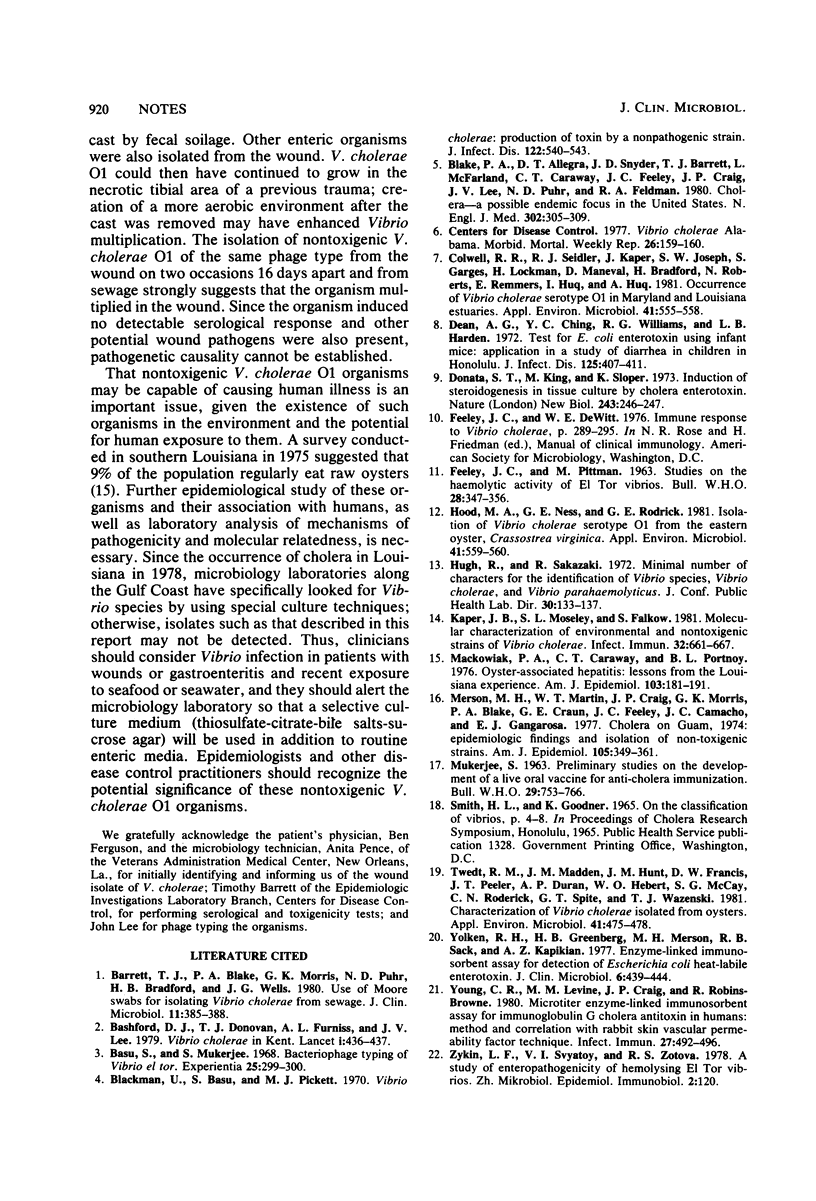Abstract
Vibrio cholerae serotype O1 organisms that do not produce cholera toxin and, in fact, lack the genetic material encoding the enterotoxin have recently been detected in coastal regions of the United States. Although these organisms have been assumed to be nonpathogenic, they have been considered a potential reservoir of toxigenic V. cholerae. In 1979, nontoxigenic V. cholerae O1 was isolated from a leg wound of an accident victim residing in New Orleans. The only known risk factors of the patient, besides his debilitated condition, were alcoholism and the consumption of raw oysters before recognition of his wound infection. Coincident with the identification of the isolate from the leg wound, an identical nontoxigenic V. cholerae O1 isolate was cultured from the sewage system serving the residence of this patient. Nontoxigenic V. cholerae O1 seems to be capable of multiplying in human tissue and may produce extraintestinal infection. This indigenous inhabitant of temperate coastal regions may not be avirulent and may be of public health significance.
Full text
PDF


Selected References
These references are in PubMed. This may not be the complete list of references from this article.
- Barrett T. J., Blake P. A., Morris G. K., Puhr N. D., Bradford H. B., Wells J. G. Use of Moore swabs for isolating Vibrio cholerae from sewage. J Clin Microbiol. 1980 Apr;11(4):385–388. doi: 10.1128/jcm.11.4.385-388.1980. [DOI] [PMC free article] [PubMed] [Google Scholar]
- Bashford D. J., Donovan T. J., Furniss A. L., Lee J. V. Vibrio cholerae in Kent. Lancet. 1979 Feb 24;1(8113):436–437. doi: 10.1016/s0140-6736(79)90906-1. [DOI] [PubMed] [Google Scholar]
- Basu S., Mukerjee S. Bacteriophage typing of Vibrio eltor. Experientia. 1968 Mar 15;24(3):299–300. doi: 10.1007/BF02152832. [DOI] [PubMed] [Google Scholar]
- Blachman U., Basu S., Pickett M. J. Vibrio cholerae: production of toxin by a nonpathogenic strain. J Infect Dis. 1970 Dec;122(6):540–543. doi: 10.1093/infdis/122.6.540. [DOI] [PubMed] [Google Scholar]
- Blake P. A., Allegra D. T., Snyder J. D., Barrett T. J., McFarland L., Caraway C. T., Feeley J. C., Craig J. P., Lee J. V., Puhr N. D. Cholera--a possible endemic focus in the United States. N Engl J Med. 1980 Feb 7;302(6):305–309. doi: 10.1056/NEJM198002073020601. [DOI] [PubMed] [Google Scholar]
- Colwell R. R., Seidler R. J., Kaper J., Joseph S. W., Garges S., Lockman H., Maneval D., Bradford H., Roberts N., Remmers E. Occurrence of Vibrio cholerae serotype O1 in Maryland and Louisiana estuaries. Appl Environ Microbiol. 1981 Feb;41(2):555–558. doi: 10.1128/aem.41.2.555-558.1981. [DOI] [PMC free article] [PubMed] [Google Scholar]
- Dean A. G., Ching Y. C., Williams R. G., Harden L. B. Test for Escherichia coli enterotoxin using infant mice: application in a study of diarrhea in children in Honolulu. J Infect Dis. 1972 Apr;125(4):407–411. doi: 10.1093/infdis/125.4.407. [DOI] [PubMed] [Google Scholar]
- Donta S. T., King M., Sloper K. Induction of steroidogenesis in tissue culture by cholera enterotoxin. Nat New Biol. 1973 Jun 20;243(129):246–247. doi: 10.1038/newbio243246a0. [DOI] [PubMed] [Google Scholar]
- FEELEY J. C., PITTMAN M. Studies on the haemolytic activity of El Tor vibrios. Bull World Health Organ. 1963;28(3):347–356. [PMC free article] [PubMed] [Google Scholar]
- Hood M. A., Ness G. E., Rodrick G. E. Isolation of Vibrio cholerae serotype O1 from the eastern oyster, Crassostrea virginica. Appl Environ Microbiol. 1981 Feb;41(2):559–560. doi: 10.1128/aem.41.2.559-560.1981. [DOI] [PMC free article] [PubMed] [Google Scholar]
- Kaper J. B., Moseley S. L., Falkow S. Molecular characterization of environmental and nontoxigenic strains of Vibrio cholerae. Infect Immun. 1981 May;32(2):661–667. doi: 10.1128/iai.32.2.661-667.1981. [DOI] [PMC free article] [PubMed] [Google Scholar]
- MUKERJEE S. PRELIMINARY STUDIES ON THE DEVELOPMENT OF A LIVE ORAL VACCINE FOR ANTI-CHOLERA IMMUNIZATION. Bull World Health Organ. 1963;29:753–766. [PMC free article] [PubMed] [Google Scholar]
- Mackowiak P. A., Caraway C. T., Portnoy B. L. Oyster-associated hepatitis: lessons from the Louisiana experience. Am J Epidemiol. 1976 Feb;103(2):181–191. doi: 10.1093/oxfordjournals.aje.a112216. [DOI] [PubMed] [Google Scholar]
- Merson M. H., Martin W. T., Craig J. P., Morris G. K., Blake P. A., Craun G. F., Feeley J. C., Camacho J. C., Gangarosa E. J. Cholera on Guam, 1974: epidemiologic findings and isolation of non-toxinogenic strains. Am J Epidemiol. 1977 Apr;105(4):349–361. doi: 10.1093/oxfordjournals.aje.a112393. [DOI] [PubMed] [Google Scholar]
- Yolken R. H., Greenberg H. B., Merson M. H., Sack R. B., Kapikian A. Z. Enzyme-linked immunosorbent assay for detection of Escherichia coli heat-labile enterotoxin. J Clin Microbiol. 1977 Nov;6(5):439–444. doi: 10.1128/jcm.6.5.439-444.1977. [DOI] [PMC free article] [PubMed] [Google Scholar]
- Young C. R., Levine M. M., Craig J. P., Robins-Browne R. Microtiter enzyme-linked immunosorbent assay for immunoglobulin G cholera antitoxin in humans: method and correlation with rabbit skin vascular permeability factor technique. Infect Immun. 1980 Feb;27(2):492–496. doi: 10.1128/iai.27.2.492-496.1980. [DOI] [PMC free article] [PubMed] [Google Scholar]
- Zykin L. F., Sviatoi V. I., Zotova R. S. Izuchenie enteropatogennosti gemoliziruiushchikh vibrionov El' Tor. Zh Mikrobiol Epidemiol Immunobiol. 1978 Feb;(2):118–120. [PubMed] [Google Scholar]


